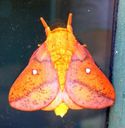Royal Moths
Ceratocampinae
Classification
- Phylum: Arthropoda
- Subphylum: Hexapoda
- Class: Insecta
- Order: Lepidoptera
- Superfamily: Bombycoidea
- Family: Saturniidae
- Subfamily: Ceratocampinae
Pronunciation
How to pronounce Ceratocampinae: /ˌsɛ.rə.toʊˈkæm.pɪ.naɪ/
These audio files are automatically generated. While they are not always 100% accurate, they are a good starting point.
Images






Summary
Ceratocampinae is a subfamily of moths within the Saturniidae family, recognized for its diverse species native to the New World, particularly North America. Previously classified under Citheroniinae, this group contains 22 species across 5 genera and plays an important role in their ecosystems.
Habitat
Ceratocampinae species are found in various habitats across North America, typically associated with forests and subtropical environments.
Distribution
Species are distributed in the New World, particularly North America.
Tags
- Ceratocampinae
- Royal Moths
- Saturniidae
- Lepidoptera
- North America